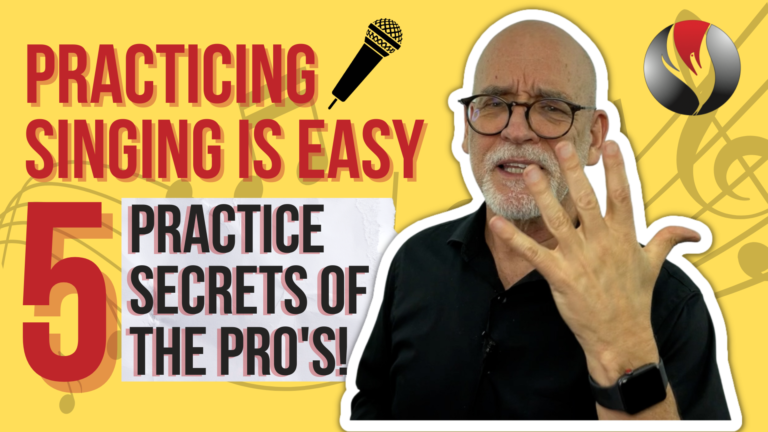What is the soft palate and why are we told to raise the soft palate when singing?
Inside this video I’m going to tell you why it’s a bad idea and what to do about it!
Singing Tips – Stop Manipulating the Soft Palate – Your Anatomy
Inside the roof of your mouth the front part is hard…you press against it with your finger and feel the bone behind the tissue lining. That’s the hard palate. Trace your hard palate further back and you can feel when the bone ends and it’s just soft tissue. That’s your soft palate.
When we sing, our vocal cords send a column of air upwards and depending on the pitch and the vowel it hits our hard or soft palates or both together.
The sound waves activate the air in the mouth cavity, the bony hard palate, and the tissue of the soft palate.
Sometimes the resonance activates more of the soft palate and uvula (the little hangy-down part in the back of your throat), travels through the soft palate and resonates in the spaces above the soft palate in the nasal cavities and surrounding tissues.
Then almost instantly the sound travels out the mouth.
Two Youtube subscribers were talking about sounding nasal. One suggested the other raise his soft palate to eliminate the nasal sound.
He gave the following well meaning suggestions:
“Watch yourself in the mirror. Open your jaw in a comfortable position and try to figure it out by putting your finger to your jaw joint and watching yourself. Throat is just a pass-through. Your engine and power comes from the diaphragm. You basically sing from there, forget your throat.
Your neck, tongue, shoulders should always relax. Your throat’s only task is to relax and give way to the sound. Raising your soft palate doesn’t come with flexing or tension.”
Singing Tips – Stop Manipulating the Soft Palate – Problems
Here’s the problem with the direction: “Raise the soft palate”. As soon as a teacher directs the student to raise the soft palate, the student begins to introduce tension into the throat, neck, mouth and tongue as they try to figure out how to do it.
The end result is more tension, the voice is thrown further out of balance and there’s no improvement in tone.
The same problems exist with: Place the tone forward. Put it in the mask. Sing from your diaphragm. Open your throat. Etc.
Students come to teachers because they don’t know how to do these things in the first place.
A better and faster way to is to give vocal exercises that cause the needed results.
For example:
- Dopey gee’s will lower the larynx, raise the soft palate and eliminate the nasal sound. [Demo]
- Bratty neys will bring the sound forward. [Demo]
- Narrowing a vowel will allow the resonance to shift above the soft palate. [Demo]
It’s called cause and effect. The vocal exercises cause a physical effect which balances and improves the singing voice.
The singer won’t add more tension manipulating the soft palate or other body parts.
You get faster results easier.
This is what the exercises do in PowerToSing.com. They cause physical effects that balance and improve your voice.
Visit PowerToSing.com, and take the vocal test, which I call the PowerTest. Take the quiz and discover your vocal type. You vocal type is what you tend to do as you sing from chest to head voice.
Then go to the Knowledge Center and watch the videos about your vocal type. Download the free exercises. The exercises will cause you to improve your voice rapidly.
If you liked this video, be sure to give it a thumbs up and subscribe and share with a friend.
I’m Chuck Gilmore with Power To Sing. You can sing higher with beauty, confidence and power.
I’ll see you inside the next video.











Responses
Thanks! This helped me a lot. I am autistic and as a result of this (and Epstein barr) had two mini strokes that partially paralyzed the right side of my face/vocal chords. I have been working extremely hard to rehab and re-tone these muscles so that they function properly.
I have also hated the nasality of my voice… and always wondered why I seem/feel like I talk in a heady mixed voice. (As opposed to chest like most men) I speak around C3 and can hit C5 easily. (C6 in a belt with proper technique.)
Which after some research. I discovered the nasality, is a side effect of, my childhood tonsil/adenoidectomy. (I have to put extra effort into closing my soft palet cause there is less tissue. Yet the good news it that I CAN do it.)
My whole life I have always unknowingly sang and spoke in mixed voice… as a result I have developed this amazingly strong and reinforced falsetto most baritones will never achieve. (Because echolalia from autism had me imitating music by Maria Carey, B2M, MJackson, and classic rock music.)
Once I started learning proper techniques. I discovered I actually can close off my sinuses with my soft palet! It just seems to be a bit “lazy”. I was blown away by how deep I could actually sing in a proper chest voice. I can hit a D1, but naturally, my chest voice is around D2. (The D1 is cause my chords have stretched so much from singing high ????)
All the above has made re-learning how to sing very difficult. Having a 4-5 octave range as a beginner can be very overwhelming and confusing. Because of my past I can easily get stuck in mixed voice… Yet I can just as easily get stuck in chest voice. My soft palet seems to get stuck in open or closed positions. Which is bad… but as a result has made my overlap range vary wide. I can push a chest voice to C5… I can push a mixed voice down to C2.
A good analogy would be… I feel like a base player who has just been handed a 12 string guitar ????
The other problem I have… Is the result of being a lead guitar player and too much “singing along with other artists tracks”. I sometimes sing the wrong note of a melody… because I am so used to being allowed to harmonize with any note in the corresponding chord.
Yet every once in awhile I hit this sweet spot. I am able to just “let go” and everything just kinda falls into place. All my practice comes together and I sound amazing. I and can easily sing crazy, dynamic, runs and riffs throughout my entire range. Without any thoughts or inhibitions. (This come from practicing scales on guitar.)
It’s these random special occasions that while short lived, show me what I am capable of, and it’s that which inspires me to keep pushing and exploring.
After a practice session… My heady nasal speaking voice become so deep and rich. It sounds like thunder. Sadly, this wears off after time.
Thanks Sherry!
Good information here! I am always trying to get my students to relax….dopey gee’s and bratty neys are a VERY good way to do so, but you have to do the exercises regularly. Thanks for another great video tip!! 🙂